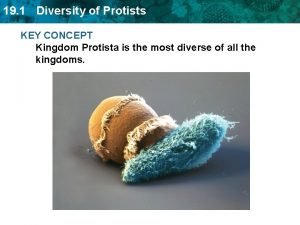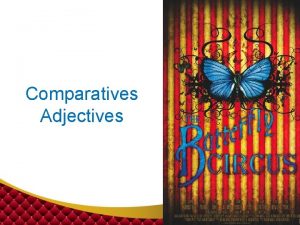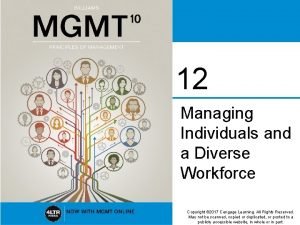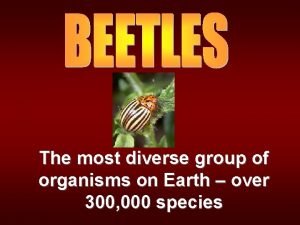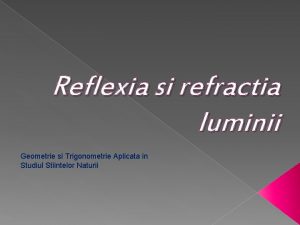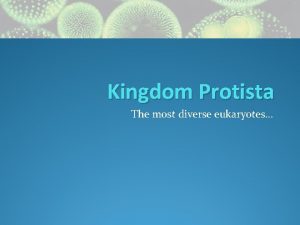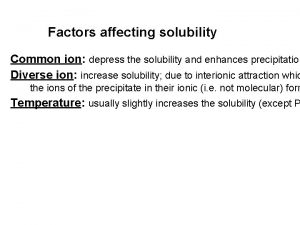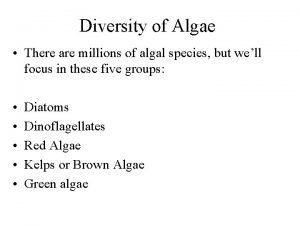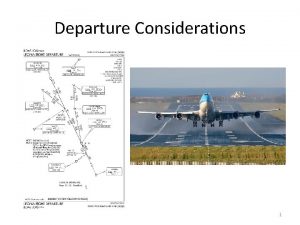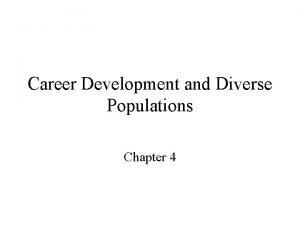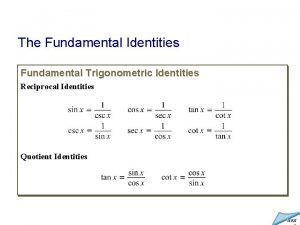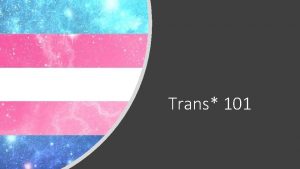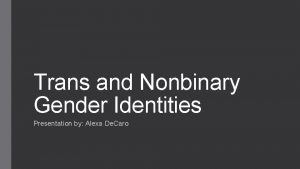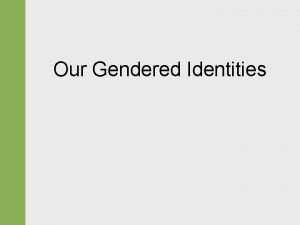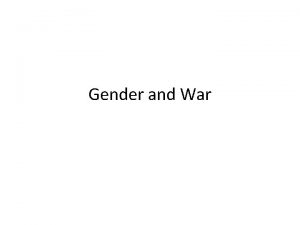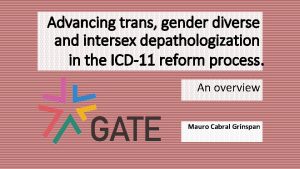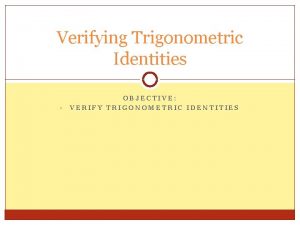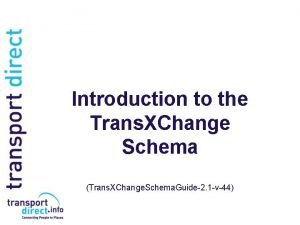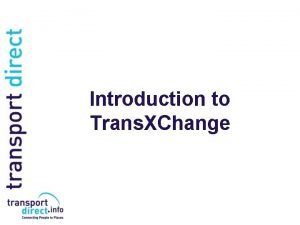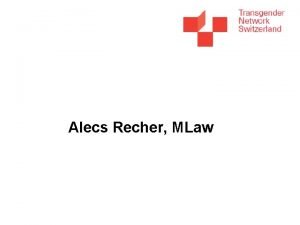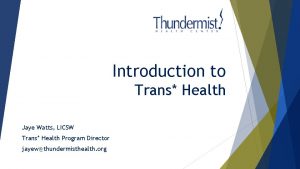Introduction to Trans and Gender Diverse Identities What















- Slides: 15

Introduction to Trans and Gender Diverse Identities

What is gender? Gender Identity: How people interpret and view themselves, within the context of wider society and culture. Gender Expression: How people present themselves. People might present as feminine, masculine, neutral or a combination, and this may vary. sex, s ’ n o s r e Ap and , y t i t n e d i gender ession r p x e r e d gen not d n a y r a v may d correspon Sex: The biological characteristics of a person’s body, i. e. organs and DNA. Usually this is male, female, or intersex.

Gender identity vs. Assigned gender Gender is assigned at birth based on physical sex – i. e. It’s a girl! or It’s a boy! – and people are generally raised in this gender role. This is called Gender Identity: Gender is how people interpret and view themselves. A person might identify as the gender they were assigned at birth (cisgender) or they may identify differently (transgender).

Gender identity also differs from sexual orientation… Sexual and Romantic Attraction: Who you are sexually and/or romantically attracted to. Sexual orientations can include heterosexual, lesbian, gay, bisexual, queer, and asexual. Trans status is not the same as sexuality. For example, you can be trans and heterosexual, or you can be trans and gay.

So what is trans? The term transgender – or trans – refers to people who do not fully identify with the gender and / or sex they were assigned at birth. In simple terms, this can include: I’m a woman, and I was assigned male at birth. Trans Women I’m a man, and I was assigned female at birth. Trans Men Non-binary and gender diverse people experience their gender identity as outside of the binary of man and woman Non-Binary people Gender diverse people

So what is cisgender? The opposite of transgender • Term for people whose gender identity matches the gender they were assigned at birth • Non-pejorative term (in our usage) • Allows for discussion of gender and difference without using problematic language e. g. normal, usual… • Latin prefix meaning ‘on this side of’ in comparison to trans which means ’on the other side of’

And what is gender diversity? We use the term ‘gender diverse’ to refer to people who experience their gender identity outside of the binary of male and female. This term is also useful for people who are questioning or unsure about their gender identity. We use this term in addition to ‘trans’ because some nonbinary, genderqueer, agender, and gender-variant people do not use the term ‘trans’ to describe their identities.

Identity terms There are many identity terms that trans and gender diverse people may use. (Trans) Man (Trans) Woman Agender Non-Binary Genderqueer Person with a trans history Person of trans experience There’s no need to learn them all – just have an open, compassionate and respectful approach. Transgende r Transsexual

Is ‘intersex’ different? Yes it is! Intersex refers to people who are born with primary sex characteristics – such as genitals and chromosome patterns – that do not fit typical binary notions of male and female. This is about chromosomal or physical sex and not gender identity. Some intersex people might be trans or gender diverse, while other intersex people might identify with the gender they were assigned at birth. Specific provision and support for intersex people is required, as needs and circumstances often differ from those of trans and gender diverse people.

What is ‘transitioning’? Transitioning is when a person takes steps to socially and /or physically feel more aligned with their gender identity. Social Transition Social transition refers to social interactions and processes, such as ‘coming out’ as trans to yourself and your friends, family and peers. Physical Transition Physical transition can involve making changes to your appearance, gender presentation and gender expression. It can also involve access to medical interventions, such as: • Hormone therapy • Hair removal • Voice therapy • Surgeries It can also involve changes to: • Name, pronouns and language • How you use gendered spaces and services • Documentation and identification Each person’s experience of transition is different …and not everyone uses the term ‘transition’!

Gender dysphoria is an intense discomfort or distress a trans or gender diverse person may feel about their physical attributes and about how they are gendered by other people. This discomfort or distress is often characterised as a mismatch between physical sex and gender identity. ‘Gender dysphoria’ is currently the clinical diagnosis given to trans and gender diverse people seeking medical treatment.

Pronouns are the terms we use to refer to each other, such as: He / Him / His Ze/Hirs She / Hers They / Them / Theirs on s Mat Him / He Take time to learn and use people’s correct pronouns.

What the law says The main legislation for the education sectors is the Equality Act 2010. The Act prohibits discrimination on the grounds of the ‘protected characteristic’ of ‘gender reassignment’, defined as: A person has the protected characteristic of gender reassignment if the person is proposing to undergo, is undergoing or has undergone a process (or part of a process) for the purpose of reassigning the person's sex by changing physiological or other attributes of sex. (Equality Act 2010)

‘Gender reassignment’. . ? As clarified by the Equality and Human Rights Commission’s Technical Guidance for FE and HE: • ‘Under the Act ‘gender reassignment’ is a personal process, (that is, moving away from one’s birth sex to the preferred gender), rather than a medical process’ • ‘It may include undergoing the medical gender reassignment treatments, but it does not require someone to undergo medical treatment in order to be protected’ • ‘This broad, non-medical definition is particularly important for gender variant young people […] they may have begun a personal process of changing their gender identity and be moving away from their birth sex. Manifestations of that personal process, such as mode of dress, indicate that a process is in place and they will be protected under the Act. ’ (EHRC, 2014: 22)

Types of discrimination The Equality Act 2010 sets out four main categories of discrimination: • Direct discrimination – Treating someone with a protected characteristic less favourably than others; • Indirect discrimination – Putting rules or arrangements in place that apply to everyone, but that put someone with a protected characteristic at an unfair disadvantage; • Harassment – Unwanted behaviour linked to a protected characteristic that violates someone’s dignity or creates an offensive environment for them; • Victimisation – Treating someone unfairly because they’ve complained about discrimination or harassment. This also covers those who are perceived as having a certain protected characteristic and those who are associated with a person with a protected characteristic.
 Diversity among protoctista
Diversity among protoctista Strategic gender needs and practical gender needs
Strategic gender needs and practical gender needs Circus possessive form
Circus possessive form Working with culturally and linguistically diverse families
Working with culturally and linguistically diverse families Vanier institute of the family definition
Vanier institute of the family definition Surface level diversity
Surface level diversity Most diverse group of organisms
Most diverse group of organisms Ce este refractia luminii
Ce este refractia luminii The most diverse kingdom
The most diverse kingdom Diverse information sharing through universal web access
Diverse information sharing through universal web access Forme di stato
Forme di stato Nh3ag
Nh3ag Algae diversity
Algae diversity Diverse societies in africa worksheet answers
Diverse societies in africa worksheet answers Diverse departure
Diverse departure Gage definition
Gage definition
